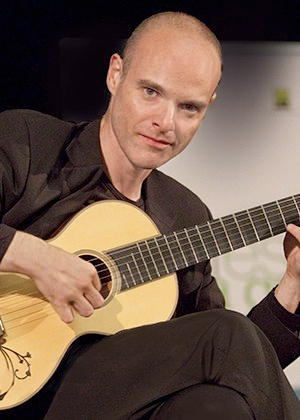by Mike Telin

Mike Telin: What an exciting program: the complete lute works of Bach.
Ricardo Gallén: Armin Kelly asked me to play the full program from my CD, Bach: Complete Lute Works at this year’s Festival, so I said, “OK, let’s do it.”
MT: This project is like a pianist taking on the complete Beethoven sonata cycle. Could you talk about how you began to wrap your mind around this repertoire?
RG: For many years when I performed different Bach suites for the lute, my students said “You should do something with these; the way you play Bach is unique.” I played the four suites in 2006, and when I began thinking about the recording project, I realized that I wanted to record all the pieces.
I had an old recording by Hopkinson Smith on baroque lute, and of course I would love to play these pieces on lute in the future, but for now I wanted to show that it’s possible to play them close to the correct style on guitar. I played the suites for four years in concerts, and I wanted to record in 2008. I was technically prepared, but when I listened to some of my live recordings I realized the performances were not exactly what I wanted to hear. I put the project aside, and for half a year I didn’t play those pieces at all.
Then a good friend came to visit me here in Weimar, and we went to the Bach museum in Eisenach and visited Bach’s grave at the Thomaskirche in Leipzig, where I felt a kind of mystical aura. We came back to Weimar, and my friend asked me if I would play the Bach suites for him because he hadn’t heard them for a long time. Relaxing with a glass of wine, and inspired by our visits to the Bach Museum, I started to play. I felt totally free. I wasn’t thinking about technique or style. When I finished, I thought, now is the time, now I really feel prepared. I was even improvising ornaments that I never played before.
That was in February of 2010. I called Norbert Kraft, a very close friend of mine who is an engineer for Naxos in Toronto, and asked him if he had a free day to record. “Is September OK for you?” I said, Let’s do it, man! It was like a dream. I knew that the church where Norbert was recording most of the guitar series is really amazing for the instrument. Most of the ornaments on the CD were improvised in the moment — my mind felt free and I was really inspired.
MT: Which church was it?
RG: It was St. John Chrysostom Church in Newmarket, about half an hour outside Toronto.
MT: I notice that for this recital you’re going to be performing on one of Bernhard Kresse’s instruments. Did you use his instrument on the recording?
RG: No, I used a copy of an 1820 Fabricatore made by Arnoldo Garcia, an Argentine-Spanish maker.
MT: When choosing an instrument for Bach, what kind of guitar are you specifically looking for?
RG: I look for an instrument that sounds closer to the lute than the modern guitar. That’s why I chose the Fabricatore. It’s bright, but it sounds more in the style of the lute. The pitch is at 415 and the gut strings make the instrument’s tone a bit deeper.
MT: Your sound on the recording is absolutely gorgeous. Did I hear you say that you play the lute?
RG: Not really. I have ordered one and I’m waiting for it. I have a theorbo, but I don’t really play it. I’m used to reading music from the bass line to the treble, but using tabulature, you have to read from top to bottom. It’s really weird for me. With the theorbo, you mostly play continuo. I’m more into solo music.
MT: Do you have a personal favorite on your program? One of the suites, or a fugue or prelude?
RG: I love BWV 998, especially the fugue. It’s one of the masterpieces among the suites. There are movements that I prefer, like the “Allemande” from the first suite, BWV 996, which is so poetical, so magical, so abstract — but precise at the same time. I also like the “Prelude” of 995, which comes from the cello suites. I think it’s so powerful. And BWV 1006 is so well-known (sings the opening bars) and somehow so predictable. But I prefer 995 because of the counterpoint. 1006 is just virtuosic and melody, more Italian in style. I love 998, and the simplicity of 999 is really amazing. It reminds me of the first prelude of the Well-Tempered Clavier, so simple but so beautiful. You can say so many things with just a few notes. That’s the greatness of Bach.
MT: You started performing very young.
RG: I started learning when I was 4, and I think the first time I performed in front of an audience — maybe for just two minutes, a very small piece — I was 4-1/2 or nearly 5.
MT: Did you ever consider doing something else in music other than playing the guitar?
RG: I remember being six years old and knowing that I wanted to devote my life to music. There have been moments of desperation where I wanted to give up the instrument and send everything to hell, maybe to go into an office and work a normal job and have a normal life. But whenever a crazy idea comes into my mind, I think, no, I really cannot live without music — without trying to make music, even if it’s for myself. I need to sit down at my piano — I’m self-taught — and play a little bit, and if it’s not perfect, I don’t care. I need it. It’s my air!
Published on ClevelandClassical.com May 27, 2015.
Click here for a printable copy of this article


